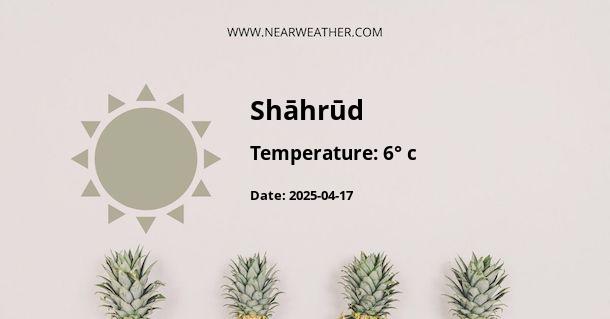Introduction
Shahrud is a city located in the northern part of Iran, known for its diverse climate and beautiful natural landscapes. It is situated in the Semnan Province and is one of the oldest cities in Iran, with a rich history dating back to ancient times. This article will provide a detailed overview of the climate and weather conditions of Shahrud, including average temperatures, precipitation, humidity, and more.
Geographical Location
Shahrud is located in the northern part of Iran, within the Semnan Province. It lies between the northern slopes of the Alborz Mountains and the Dasht-e Kavir desert, which gives it a unique geographical diversity. This location affects the city's climate significantly, making it one of the most climatically diverse cities in Iran.
Climate Overview
The climate in Shahrud is classified as a cold desert climate, according to the Köppen-Geiger climate classification. The city experiences large temperature variations between seasons, with hot summers and cold winters. However, due to its geographical location, it also experiences a diverse range of microclimates, including mountainous, desert, and semi-arid climates.
The city's average annual temperature is around 13.5°C. In summer, the average temperature can rise to above 30°C in July, while in winter, it can drop to below -2°C in January.
Seasonal Weather Patterns
- Spring: Spring in Shahrud begins in March and lasts until May. The weather during this season is mild, with average temperatures ranging between 10°C and 20°C. It is also the wettest season of the year, with the highest levels of rainfall.
- Summer: Summer in Shahrud is hot and dry, starting in June and ending in August. The average high temperature during this season is around 30°C, with occasional peaks reaching up to 35°C. Rainfall is minimal during summer.
- Autumn: Autumn starts in September and ends in November. The weather during this season is relatively mild, with average temperatures ranging between 10°C and 20°C. Rainfall levels are moderate compared to spring and summer.
- Winter: Winter in Shahrud is cold and dry, starting in December and ending in February. The average low temperature during this season is around -2°C, with occasional drops reaching up to -10°C. Snowfall is common during winter, especially in the mountainous areas.
Precipitation and Humidity
Shahrud receives minimal annual precipitation, with an average of around 150mm per year. The majority of the rainfall occurs during the spring season, while the summer is the driest season. The average relative humidity in Shahrud is around 50%, which is considered moderate.
Conclusion
In conclusion, Shahrud's climate is characterized by its large seasonal temperature variations and low annual precipitation. Its geographical location within the Alborz Mountain range and near the Dasht-e Kavir desert contributes to its diverse range of microclimates. Despite the extreme weather conditions during summer and winter, Shahrud attracts a number of visitors due to its unique landscapes and rich historical heritage.
Whether you are a traveler seeking adventure in the mountains or a researcher interested in studying unique climates, Shahrud offers a wide range of opportunities for exploration and discovery.
A - Shāhrūd's Latitude is 36.416672 & Longitude is 55.016670.
A - Weather in Shāhrūd is 6° today.
A - Climate Conditions in Shāhrūd shows clear sky today.
A - Humidity in Shāhrūd is 69% today.
A - Wind speed in Shāhrūd is 23.58 km/h, flowing at 12° wind direction. today.
